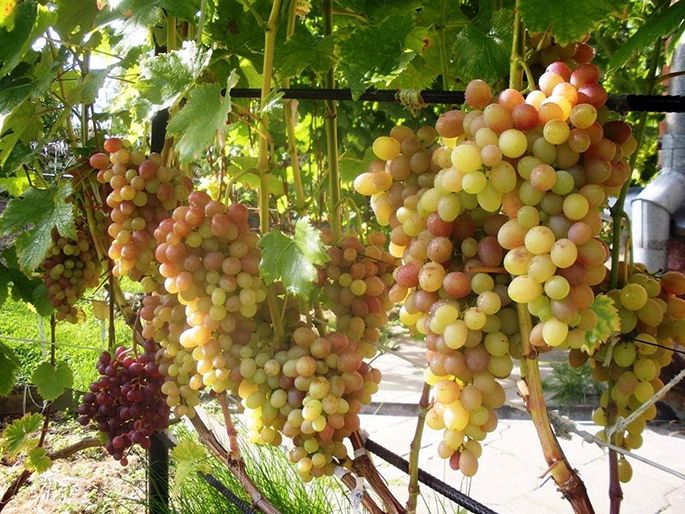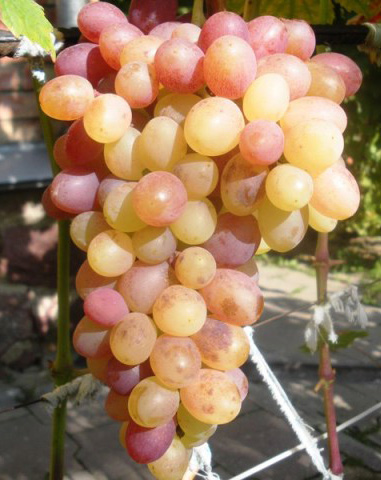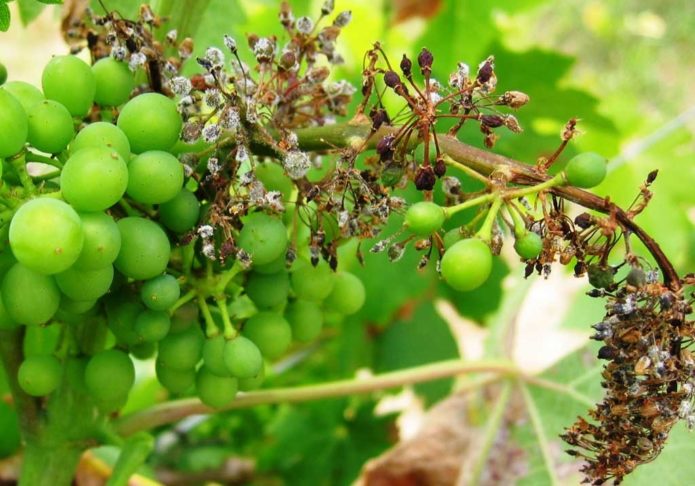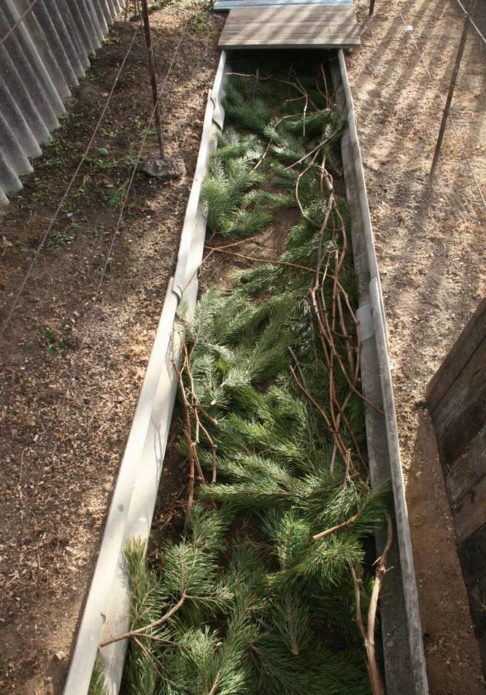The grapes of the very early ripening period Tason are considered by many experts to be the best in their segment. As a representative of varieties that ripen at the end of July, it also has a high frost resistance, which makes it possible to obtain harvests of berries that are remarkable in taste even in the Leningrad Region. It is grown by both hobbyists and farmers who sell grapes.
Content
Breeding history, description and characteristics of the Tason grape variety
Tason is a grape of Russian origin, obtained at VNIIViV im. ME AND. Potapenko. The institute, located in Novocherkassk (Rostov region), has been working on new varieties for over 80 years. This grape, obtained by hybridization of Italy and Zoreva varieties, has been known for a long time and has passed the test of time. It is known that one of the "parents" - Italy - is famous for its pronounced nutmeg taste, and the other - Zoreva - participated in instilling in Tason the ability to ripen very quickly.
In his homeland, Tason begins to produce ripe berries in mid-July, and by August the harvest is already mostly ripe. Of course, in the more northern regions of the country, the harvest time is somewhat shifted towards autumn, but the short growing season allows this variety to be grown even in the North-West of Russia. Of course, in a harsh climate, it requires serious shelter for the winter, since its frost resistance is at the level of most modern varieties: Tason can withstand temperatures of -22 without shelter. aboutC. But the short northern summer is enough for him to go through the entire cycle from budding to the readiness of the crop, which takes from 100 to 110 days.
Tason bushes are very large, shoots grow quickly, covered with large dark green leaves of regular shape, strongly dissected. Shoots ripen almost to their full length. Fruitful among them - just over half. It easily propagates by all available methods, except, of course, seed (during seed propagation, the characteristics of the variety are not transmitted). The most popular and easiest way to get new bushes is by rooting cuttings, which is almost 100% successful. Compatible with most traditional rootstocks, so grafting is also successfully used.
A huge disadvantage of the variety is its very weak resistance to fungal diseases of grapes: mildew and powdery mildew. However, due to early maturity, this rarely affects the harvest of the current year, but a diseased bush without proper treatment can manifest itself from the worst side next year. Gray mold resistance is average.
The bisexual nature of flowers does not require the presence of other grape bushes on the site, the flowers are well pollinated. On each fruitful shoot, one or two clusters are formed, but they are quite large, so the overall yield of the variety is assessed as high. In total, the bush can provide growth and maturation of up to 40 bunches. The bunches are cylindro-conical in shape, beautiful, can reach a mass of 1.2 kg, but generally weigh from 500 to 800 g.These are not the largest bunches among the known grape varieties, but they are quite weighty in the segment of the very early grapes. The packing of berries in them is of medium friability.
The berries are aligned in the bunches, there are no peas. The transportability of the crop is at a very high level. Urgent harvesting is not necessary: the berries keep well on the bushes for a long time, do not dry out or crack.
Tason fruits are mainly colored white-pink with an amber tint, shine through in the sun, but with a lack of sunlight, they can remain almost white. They have an oval shape, rather large (2.5 x 1.8 cm), weighing about 7 g. The seeds are small, the pulp is juicy and crispy. The taste is very good, nutmeg, according to the tasters - 8.2 points. Sometimes a light strawberry flavor is felt. Sugar (about 20%) and acid (5–6 g / ml) contents are in the normal range for most table grape varieties. The peel is not felt when eaten.
The purpose of the variety is universal. First of all, its berries are intended for fresh consumption, and in this regard, Tason is considered one of the best early varieties: many experts call it even the most delicious among the tasty ones. But it can be used to prepare juices, preserves, raisins, etc. The chemical composition of the juice allows using Tason in winemaking.
For a long time, the variety was considered one of the best for sale. Now, in terms of presentation, more profitable varieties have appeared, but according to the combination of the appearance of the berries and their taste, it remains among the market leaders, grown both for personal consumption and for sale.
Despite the fact that it was bred for the southern regions, thanks to a successful combination of consumer characteristics, it is successfully cultivated in most of the country.
Video: Tason's harvest on the bushes
Features of planting and growing Tason grapes
In terms of planting and maintenance rules, Tason is no different from most other modern table grapes. True, planting in the sunniest area is especially important for him: the berries will grow in partial shade, but will not acquire the necessary color, while significantly losing their marketable form, and they will accumulate less sugar than usual. It is better to plant grapes on the southern or southeastern side of the site, and this is especially important in the northern regions.
The bushes should be protected from the action of cold winds with a wall of the house or tall fruit trees, but they should not grow too close. Tason is a plant of considerable growth, requires a large area of nutrition, therefore, at least three meters should remain to the nearest grape bushes or other plantings. Although, of course, one bush of this grape is enough for personal consumption for a small family, it also does not need pollinators - grapes of other varieties.
Tason will grow in any soil, but it works best on light, breathable, high nutrient content. Therefore, the clay areas should be somewhat corrected by adding coarse river sand or peat. Immediately it is necessary to decide on the supports: the bush will grow large, for tying the vines it is worthwhile to build a strong trellis in advance. It is better to plan planting in most regions in April, but in the south, the October option is also practiced. You can grow a seedling from a lignified cutting on your own; it is quite simple to do this with a little experience.
For the spring planting, the place is prepared in advance, in the fall they dig a planting hole. It should be of impressive size, as for any strong grape: from 70 cm in all directions. A layer of drainage material must be placed on the bottom (except for very sandy soils) and a pipe for watering the roots in the first 2-3 years of the life of the bush must be laid.A layer (25-30 cm) of good humus mixed with soil (1: 1) with the addition of several liters of wood ash and 300-400 g of azophoska is poured onto a 15-centimeter layer of drainage, above - a layer of clean fertile soil.
In the spring, the acquired or grown seedling is planted so that the roots are in contact only with clean soil, and two buds are brought out. Water the seedling well and mulch the soil with any loose material. In the first year, watering is needed often, and then their number is significantly reduced.
Care for adult grapes consists of periodic watering, spring feeding, preventive spraying and competent pruning. The roots of grapes penetrate deeply, therefore watering is necessary only during the filling of the crop, the rest of the time it gets its own moisture. In especially arid regions, of course, watering has to be done in other periods, but without fanaticism. Watering is contraindicated 2-3 weeks before harvesting. After watering, especially for young bushes, it is necessary to loosen the soil while removing weeds. In the case of dry autumn, subwinter watering is useful, just before the bushes are sheltered for the winter.
The grapes are fed both by fertilizing the soil and by spraying the foliage. In early spring, every two years, two buckets of well-rotted manure are buried under the bush, and annually - half a bucket of wood ash. Mineral fertilizers are best applied on the leaves: foliar feeding is carried out before flowering and immediately after it, using any complex fertilizers.
Tason has a very low resistance to fungal diseases. Therefore, in addition to competent pruning aimed at lightening the bushes and eliminating waterlogging of the soil, it often has to be sprayed for preventive purposes, and in case of infection, for medicinal purposes. Processing the vine immediately after the spring release from the shelter is absolutely mandatory: at this time, a 1% solution of ferrous sulfate is used. Along the green cone (leaf extension), the treatment is repeated, changing the recipe to Bordeaux liquid. And after the appearance of several leaves, the bushes are sprayed with the drug Ridomil Gold. If during the summer the disease manifests itself, you have to alternate fungicides, but during the filling and ripening of the berries, you cannot spray the bushes with anything other than colloidal sulfur. Infected bushes must be treated with vitriol and in the fall, after leaf fall.
Pruning involves both the formation of a bush and its lightening in order to better ventilate, eliminate the possibility of introducing infections. In the spring, it is of a cosmetic nature: only clearly superfluous and not overwintered shoots are removed. Throughout the summer, shoots and stepchildren that grow out of place are broken out, while they are still green and small. It is more convenient to carry out the main pruning after leaf fall. Tason is a fairly strong grape, so up to 40 eyes can be left on an adult bush (6–8, if necessary, up to ten on each shoot).
In addition to mushroom sores, wasps are also very fond of this variety. They affect not only ripe fruits, but even those just beginning to ripen. Therefore, the fight against striped guests is also part of the responsibilities of the owner of the grapes. It is necessary to systematically remove the emerging hornets' nests. To some extent, baits made from sweet solutions with the addition of any insecticides help. But still, many growers, as the bunches grow, place them in special nets: it is not possible to cover a huge bush with a common network.
From the point of view of frost resistance, Tason is an ordinary grape: in the south it winters without shelter, but already starting from the latitude of Volgograd, for the winter it requires the removal of vines from the trellises and their shelter. If in moderately cold regions there are enough spruce branches of coniferous trees, then in the Leningrad region, shelter with roofing felt or other similar materials should be added to it.Of course, there is no need to bury the vines in the ground, except for the very harsh regions of the climate.
In general, Tason is a rather non-capricious variety, but the main problems for winegrowers are its tendency to disease and its susceptibility to wasps. But the gorgeous taste of berries and their very early ripening are worth the effort.
Video: Tason grapes in Belarus
Advantages and disadvantages of the variety in comparison with similar
Many growers believe that until recently Tason was the best among the grape varieties of the very early ripening period, but now there are varieties with the best presentation of the bunches. Nevertheless, in terms of taste, it remains among the most outstanding. If, for example, we compare Tason with the super-early Ruta, then its clear advantage, in addition to taste, is the presence of bisexual flowers. But the comparison with Libya is no longer so unambiguous: Tason's berries are considered somewhat tastier, but Libya is much more resistant to diseases. Experts include among the obvious advantages of Tason:
- very early maturation;
- good presentation;
- excellent taste typical for nutmeg varieties;
- stable and good yield;
- absence of "peas" in the bunches;
- buncation of flowers;
- the safety of berries on the bushes;
- excellent portability;
- the ability to obtain a high-quality harvest in any climatic conditions.
The obvious disadvantages include:
- weak resistance to fungal diseases;
- strong attack by wasps;
- uneven coloring of berries, depending on the weather.
Despite the noted disadvantages, which cause significant inconvenience in care, the variety is very popular both among amateurs and in a professional environment. The berries ripen one of the first and are in great demand at this time on the market.
Gardeners reviews
I am absolutely amazed at the long shelf life of this variety on the bushes. Ripe on August 5 and now on September 12 hangs in a gauze bag. The taste just got brighter than the nutmeg. The berry is absolutely pink, just as dense and juicy, I don't notice any withering, as it happened today with Krasa Nikopol (but I haven't tasted such sugar as in KN, a month after ripening in any table variety).
Yes, Tason is one of the best for me and, moreover, ripening early, remains tasty and dense all season, just an amazing variety. It is still a mystery to me how some put it on a par with Flora and Arkadia in taste. I have not met such people on my site - after Tason they do not want to eat for the first or second.
My pet and breadwinner Tason is somehow undeservedly forgotten. In my vineyard, it is one of the most revered and favorite varieties of my family. At the same time, it is also my calling card at any exhibitions. This variety requires the selection, first of all, of a good warm and well-lit place, competent and timely protection against diseases, and then a handsome man! As for the north of Belarus, I consider it to be a reference in taste and marketability for growing in OG, but in a wall culture, it produces excellent standard bunches weighing 500-600 g (in a semi-finished greenhouse up to 800 g, it grows there too) with a beautiful yellow-pink appetizing berry 6–8 g, because in the north we have no time for fat. Sugar content of the order of 17-19% is gaining quite well at low acidity, there are no special problems with the ripening of vines, and the yield is at a height. In addition, I noticed that the bunches hang pretty well for a long time on the bushes. But once again I emphasize the slack during cultivation does not forgive.
If you sawed down Tason, then next year it will trample on growing so that you cannot keep it. Follow you. year it will be necessary to do something to restrain fattening, because it turns out that it will grow, but there will be no harvest on it. I have the same problem with Veronica.She froze to death last winter, in the spring then a gorgeous vine began to grow out of the ground, but healed and did not mature, did not wake up this spring, the vine is dry. This year I am growing a bush again, the vine is very thick and fattening again. I don't even know if it will winters or not. If it does not overwinter, then in the spring I will remove the bush and plant a new one, so it will be easier to renew it. And Tason, yes, very vigorous, I will extend the bush, there is not enough space for him.
Video: expert review of the variety
The Tason grape is an honored representative of the very early varieties, which has gained fame in most of our country. Being quite frost-hardy, it allows you to get yields of very tasty fruits even in the North-West region. The disadvantages associated with poor disease resistance are offset by the advantages of the variety, which still leave it among the most sought after.







